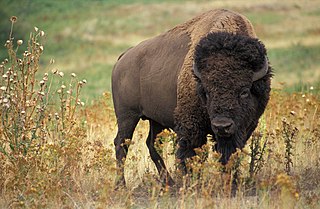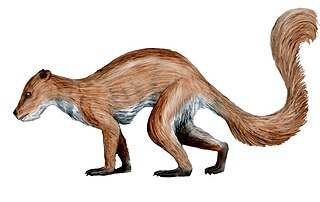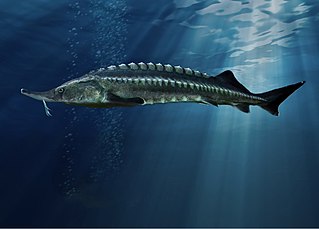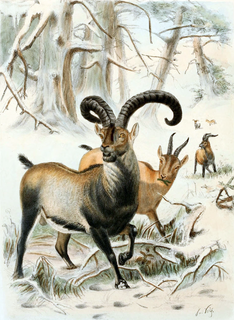
The aurochs, also known as urus or ure, is an extinct species of large wild cattle that inhabited Asia, Europe, and North Africa. It is the ancestor of domestic cattle. The species survived in Europe until 1627, when the last recorded aurochs died in the Jaktorów Forest, Poland.

Bisons are large, even-toed ungulates in the genus Bison within the subfamily Bovinae.

The true finches are small to medium-sized passerine birds in the family Fringillidae. Finches have stout conical bills adapted for eating seeds and nuts and often have colourful plumage. They occupy a great range of habitats where they are usually resident and do not migrate. They have a worldwide distribution except for Australia and the polar regions. The family Fringillidae contains more than two hundred species divided into fifty genera. It includes species known as siskins, canaries, redpolls, serins, grosbeaks and euphonias.

The Holocene extinction, otherwise referred to as the sixth mass extinction or Anthropocene extinction, is an ongoing extinction event of species during the present Holocene epoch as a result of human activity. The included extinctions span numerous families of plants and animals, including mammals, birds, reptiles, amphibians, fishes and invertebrates. With widespread degradation of highly biodiverse habitats such as coral reefs and rainforests, as well as other areas, the vast majority of these extinctions are thought to be undocumented, as the species are undiscovered at the time of their extinction, or no one has yet discovered their extinction. The current rate of extinction of species is estimated at 100 to 1,000 times higher than natural background extinction rates.
The Permian is a geologic period and system which spans 47 million years from the end of the Carboniferous period 298.9 million years ago (Mya), to the beginning of the Triassic period 251.902 Mya. It is the last period of the Paleozoic era; the following Triassic period belongs to the Mesozoic era. The concept of the Permian was introduced in 1841 by geologist Sir Roderick Murchison, who named it after the region of Perm in Russia.

Quaternary is the current and most recent of the three periods of the Cenozoic Era in the geologic time scale of the International Commission on Stratigraphy (ICS). It follows the Neogene Period and spans from 2.588 ± 0.005 million years ago to the present. The Quaternary Period is divided into two epochs: the Pleistocene and the Holocene. The informal term "Late Quaternary" refers to the past 0.5–1.0 million years.

The European bison or the European wood bison, also known as the wisent, or the zubr, is a European species of bison. It is one of two extant species of bison, alongside the American bison. The European bison is the heaviest wild land animal in Europe and individuals in the historical past may have been even larger than modern animals. During Late Antiquity and the Middle Ages, bison became extinct in much of Europe and Asia, surviving into the 20th century only in northern-central Europe and the northern Caucasus Mountains. During the early years of the 20th century bison were hunted to extinction in the wild. The species, now numbering several thousand head and returned to the wild by captive breeding programmes, is no longer in immediate danger of extinction, but remains absent from most of its historical range. It is not to be confused with the aurochs, the extinct ancestor of domestic cattle, with which it co-existed into historical times.

Extinction is the termination of a kind of organism or of a group of kinds (taxon), usually a species. The moment of extinction is generally considered to be the death of the last individual of the species, although the capacity to breed and recover may have been lost before this point. Because a species' potential range may be very large, determining this moment is difficult, and is usually done retrospectively. This difficulty leads to phenomena such as Lazarus taxa, where a species presumed extinct abruptly "reappears" after a period of apparent absence.

Struthionidae is a family of flightless birds, containing the extant ostriches and their extinct relatives. The two extant species of ostrich are the common ostrich and Somali ostrich, both in the genus Struthio, which also contains several species known from Holocene fossils such as the Asian ostrich. The common ostrich is the more widespread of the two living species, and is the largest living bird species. Other ostriches are also among the largest bird species ever.

Mammutidae is an extinct family of proboscideans that appeared during the Oligocene epoch and survived until the start of the Holocene. The family was first described in 1922, classifying fossil specimens of the type genus Mammut (mastodons), and has since been placed in various arrangements of the order. The name "mastodon" derives from Greek, μαστός "nipple" and ὀδούς "tooth", as with the genus, referring to a characteristic that distinguishes them from allied families. The genus Zygolophodon has also been assigned to this family. Mammutids ranged very widely, with fossils found in North America, Africa, and throughout Eurasia.

Pleistocene megafauna is the set of large animals that lived on Earth during the Pleistocene epoch and became extinct during the Quaternary extinction event. Megafauna are any animals with an adult body weight of over 45 kilograms (99 lb).

Ouranopithecus is a genus of extinct Eurasian great ape represented by two species, Ouranopithecus macedoniensis, a late Miocene hominoid from Greece and Ouranopithecus turkae, also from the late Miocene of Turkey.

The Late Pleistocene is an unofficial age in the international geologic timescale in chronostratigraphy, also known as Upper Pleistocene from a stratigraphic perspective. It is intended to be the fourth division of the Pleistocene Epoch within the ongoing Quaternary Period. It is currently estimated to span the time between c. 129,000 and c. 11,700 years ago. The Late Pleistocene equates to the proposed Tarantian Age of the geologic time scale, preceded by the officially ratified Chibanian and succeeded by the officially ratified Greenlandian. The estimated beginning of the Tarantian is the start of the Eemian interglacial period. It is held to end with the termination of the Younger Dryas, some 11,700 years ago when the Holocene Epoch began.

Plesiadapiformes is a group of Primates, as sister of the Dermoptera. While none of the groups normally directly assigned to this group survived, the group appears actually not to be literally extinct as the remaining primates appear to be derived Plesiadapiformes, as sister of e.g. the Carpolestidae. The term Plesiadapiformes may still be used for all primates which are not crown primates, but this usage is obviously paraphyletic. When the crown primates are cladistically granted, it becomes an obsolete junior synonym to primates. Purgatorius is believed to be a basal Plesiadapiformes.
The Late Triassic is the third and final epoch of the Triassic Period in the geologic timescale. The Triassic-Jurassic extinction event began during this epoch and is one of the five major mass extinction events of the Earth. The corresponding series is known as the Upper Triassic. In Europe the epoch was called the Keuper, after a German lithostratigraphic group that has a roughly corresponding age. The Late Triassic spans the time between 237 Ma and 201.3 Ma. It is preceded by the Middle Triassic epoch and is followed by the Early Jurassic epoch. The Late Triassic is divided into the Carnian, Norian and Rhaetian ages.

An IUCN Red List Critically Endangered (CR) species is one that has been categorized by the International Union for Conservation of Nature as facing an extremely high risk of extinction in the wild. As of 2020, there are 6,811 species that are considered to be Critically Endangered. This is out of the 120,372 species currently tracked by the IUCN.
The extinction risk of climate change is the risk of species becoming extinct due to the effects of climate change. This may be contributing to Earth's sixth major extinction, also called the Anthropocene or Holocene extinction. While the past extinctions have been due to primarily volcanic eruptions and meteorites, this sixth major extinction is attributed to human behaviors. Climate change is occurring at an alarming rate: Studies done by the Intergovernmental Panel on Climate Change (IPCC) show that it is estimated that the temperature will rise from about 1.4 to 5.5 degrees Celsius within the next century. These rising rates, to a certain degree, may benefit some regions while harming others. However, after about 5.4 degrees Fahrenheit of rising temperature, it will get into harmful climate change. Efforts have been made such as the Paris Climate Agreement, in attempt to stop or reduce the effects of a rising temperature, or at least decrease the number in which the temperature rises. However, even if this goal is accomplished, it is estimated that about 25% of their particular animal species will be lost.

An extinct comet is a comet that has expelled most of its volatile ice and has little left to form a tail and coma. In a dormant comet, rather than being depleted, any remaining volatile components have been sealed beneath an inactive surface layer.

De-extinction is the process of generating an organism that is either an extinct species or resembles an extinct species. There are several ways to carry out the process of de-extinction. Cloning is the most widely proposed method, although genome editing and selective breeding have also been considered. Similar techniques have been applied to certain endangered species, in hopes to boost populations. The only method of the three that would provide an animal with the same genetic identity is cloning. There are both pros and cons to the process of de-extinction ranging from technological advancements to ethical issues.

















